Spring is definitely here in Austin, even if the date hasn’t officially declared it so. Around town, peach, plum, pear, and dogwood trees are already gorgeously flowering. And buds of other trees and flowers are peeking out to see what’s around them, and soon there will be many more blooms and greenery to delight passersby. At home, I’m delighted to see that many of the trees and shrubs we planted in fall and winter made it through the freezes and are beginning to bud.
Goldenball Leadtree:
 Chinquapin Oak:
Chinquapin Oak:
 Mexican Redbud:
Mexican Redbud:
 We even have Salvia blooming. They, along with Gopher Plant and a variety of unknown plants (some might call them weeds), are the first official bloomers of the Great Stems garden.
We even have Salvia blooming. They, along with Gopher Plant and a variety of unknown plants (some might call them weeds), are the first official bloomers of the Great Stems garden.
 You can’t really count the hanging basket I planted a few days ago. It came with blooms. It’s my first real attempt at a container garden — I need to go check on the names of two of the plants, but the chartreuse one is sweet potato vine. I’ll enjoy watching what happens.
You can’t really count the hanging basket I planted a few days ago. It came with blooms. It’s my first real attempt at a container garden — I need to go check on the names of two of the plants, but the chartreuse one is sweet potato vine. I’ll enjoy watching what happens.
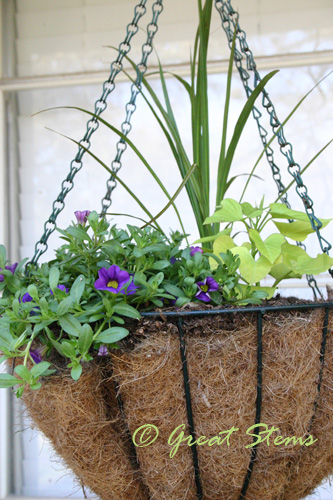
Hey, cat — get off the birdbath!
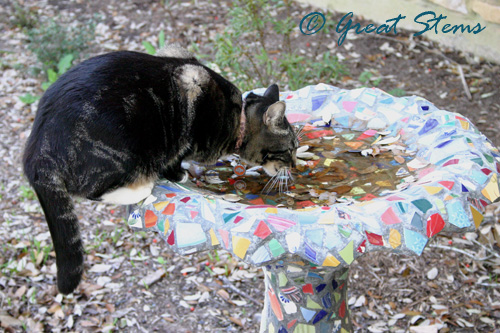 Lacey Oak:
Lacey Oak:
 A plant I put in the ground on a whim during the fall thrived all through the winter despite freezes and snow. It’s growing at a very rapid pace, too, and I need to help it climb up instead of out: coral honeysuckle. I think its new growth is very beautiful.
A plant I put in the ground on a whim during the fall thrived all through the winter despite freezes and snow. It’s growing at a very rapid pace, too, and I need to help it climb up instead of out: coral honeysuckle. I think its new growth is very beautiful.


 Cat! Get out of that birdbath, too! Gah!
Cat! Get out of that birdbath, too! Gah!
 It’s a good thing I bought a hanging birdbath on a whim, I guess — the cat won’t be able to use that one! It’s a grocery-store purchase, all of $14.95, so cute that I couldn’t resist. I added a twig as a perch (not visible in this picture).
It’s a good thing I bought a hanging birdbath on a whim, I guess — the cat won’t be able to use that one! It’s a grocery-store purchase, all of $14.95, so cute that I couldn’t resist. I added a twig as a perch (not visible in this picture).
 Looking out the study window (with the cat safely back inside), I see two birds at the mosaic birdbath and am happy to report that birds have also discovered the new feeder I put out there. Chickadees, finches, cardinals, and titmice so far… I’m taking pictures — I’ll share them in the next day or two.
Looking out the study window (with the cat safely back inside), I see two birds at the mosaic birdbath and am happy to report that birds have also discovered the new feeder I put out there. Chickadees, finches, cardinals, and titmice so far… I’m taking pictures — I’ll share them in the next day or two.
In the back I’ve got an overgrown but wildly successful vegetable garden in one bed and weeds taking over the unused beds. Must get out there and get the new garden planted… In another area, I see a strawberry bloom… and wow, there’s a broccoli head forming! My first broccoli!
 Rogue pumpkins are showing up where I left an old pumpkin out for too long. Now I’m going to have guilt when I pull them up and not let them take over the garden bed again… Maybe I’ll just move them to an open spot in the yard and let them shade out the bermuda…
Rogue pumpkins are showing up where I left an old pumpkin out for too long. Now I’m going to have guilt when I pull them up and not let them take over the garden bed again… Maybe I’ll just move them to an open spot in the yard and let them shade out the bermuda…
 Off in the wooded area, the wild yaupons are producing fantastic new growth.
Off in the wooded area, the wild yaupons are producing fantastic new growth.
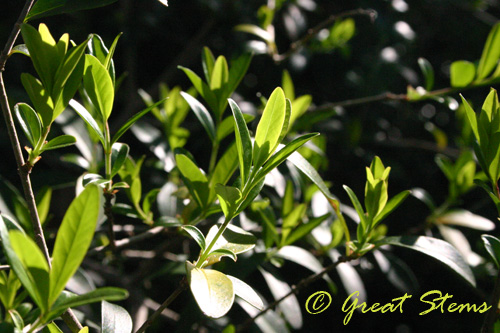 It looks like we lost two in-ground citrus trees, but the container lime and lemon trees are suddenly growing like crazy. I better give them some yummy organic fertilizer soon. Maybe I’ll see our first fruit this year. The two pomegranates we planted bare root are also starting to bud. Yay! Lime tree:
It looks like we lost two in-ground citrus trees, but the container lime and lemon trees are suddenly growing like crazy. I better give them some yummy organic fertilizer soon. Maybe I’ll see our first fruit this year. The two pomegranates we planted bare root are also starting to bud. Yay! Lime tree:
 I planted several Rusty Blackhaw Viburnums this fall. Two came from a local reader who was so wonderful to contact me when she needed to thin out some of the babies below her mother tree. These “babies” were much bigger than most of the ones I purchased! I’m happy to report that they survived their transplant and are budding right now.
I planted several Rusty Blackhaw Viburnums this fall. Two came from a local reader who was so wonderful to contact me when she needed to thin out some of the babies below her mother tree. These “babies” were much bigger than most of the ones I purchased! I’m happy to report that they survived their transplant and are budding right now.
Another Rusty Blackhaw that I purchased took some damage over the winter, and we thought it might not make it. I saw that its main trunk was split, presumably from dog damage. But I was shocked to discover after having left it in its container as is for a couple of months that it was budding. I quickly got it in the ground, and now look at it:
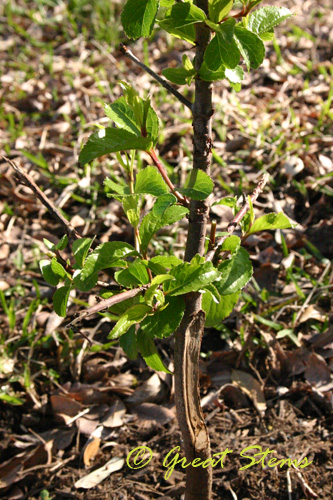
Incomplete list of trees and shrubs we planted this fall and winter, all budding or leafing:
- Anacua
- Chinquapin Oak
- Anacacho Orchid
- Evergreen Sumac
- Fragrant Sumac
- Rusty Blackhaw Viburnum (several)
- Mexican Plum
- Carolina Buckthorn
- Flowering Senna
- Mexican Silk Tassel
- Canyon Mock Orange
- American Beautyberry
- Wax myrtle
- Pomegranate (two varieties)
Lost to freeze and/or dogs:
- Lime tree
- Possibly Satsuma Mandarin Orange
- Kidneywood (one of two)
- Barbados Cherry (one of two)
Jury’s still out on:
- Mexican Anacacho Orchid, transplanted
- Toothache Tree (very small)
All in all, that’s not a bad record, given the amount of damage my dogs did last year! I see that some of our perennials are coming up (among the weeds that went crazy). I’ll start assessing those soon.
Hey, bud. It makes my heart happy to see you!

(Mexican Redbud)






















 Lindheimer Senna…
Lindheimer Senna…




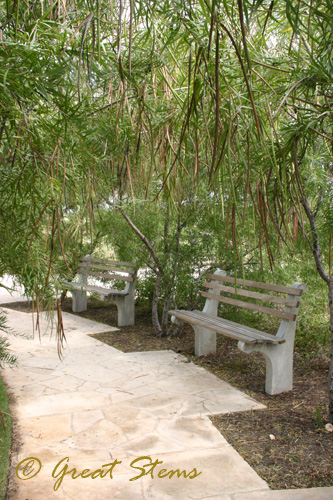 A view of the three ponds, surrounded by native grasses…
A view of the three ponds, surrounded by native grasses…

 But aside from its beauty, what makes this shrub truly valuable is that it is a fall and winter food source for more than 40 different songbird species, as well as other birds. It also is enjoyed by mammalian wildlife, including the opossum and raccoon. Its deer resistance probably depends on your area and the harshness of seasonal weather. In some areas, deer leave the mature plants alone, but they’re happy to nibble on young shrubs and sometimes the berries. In general, though, it’s best to plant the shrub in a protected area if you are concerned about deer.
But aside from its beauty, what makes this shrub truly valuable is that it is a fall and winter food source for more than 40 different songbird species, as well as other birds. It also is enjoyed by mammalian wildlife, including the opossum and raccoon. Its deer resistance probably depends on your area and the harshness of seasonal weather. In some areas, deer leave the mature plants alone, but they’re happy to nibble on young shrubs and sometimes the berries. In general, though, it’s best to plant the shrub in a protected area if you are concerned about deer.
